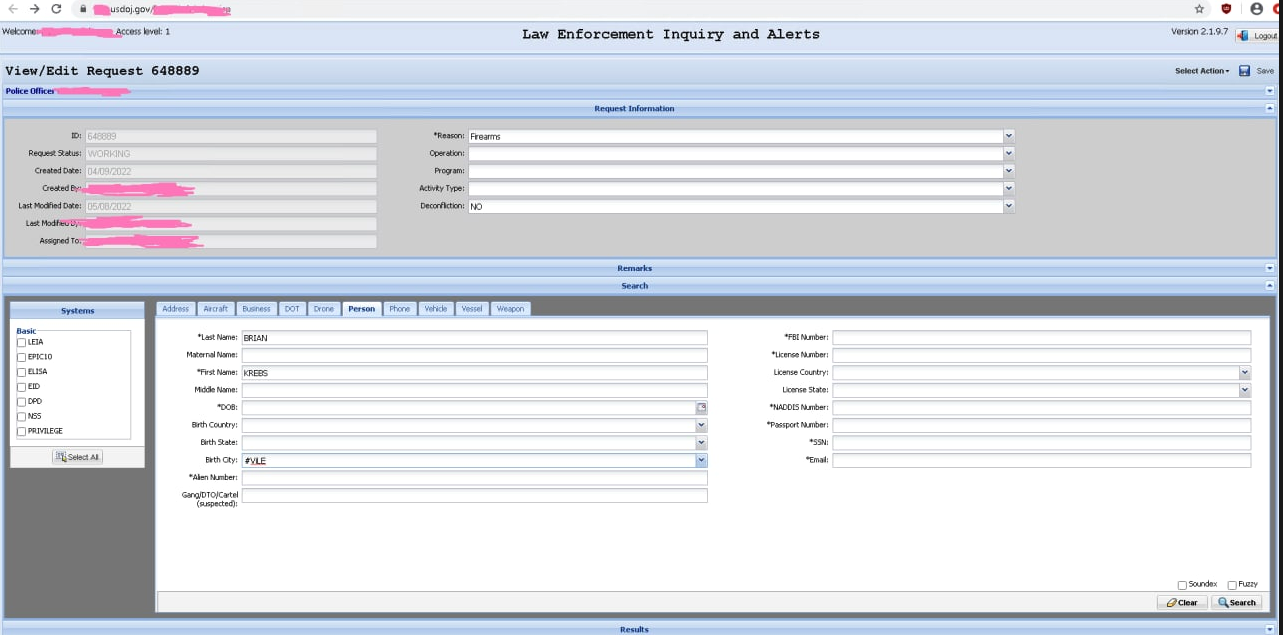


ESET researchers analyzed Android and Windows clippers that can tamper with instant messages and use OCR to steal cryptocurrency funds
The post Not‑so‑private messaging: Trojanized WhatsApp and Telegram apps go after cryptocurrency wallets appeared first on WeLiveSecurity



Microsoft on Tuesday released updates to quash at least 74 security bugs in its Windows operating systems and software. Two of those flaws are already being actively attacked, including an especially severe weakness in Microsoft Outlook that can be exploited without any user interaction.

The Outlook vulnerability (CVE-2023-23397) affects all versions of Microsoft Outlook from 2013 to the newest. Microsoft said it has seen evidence that attackers are exploiting this flaw, which can be done without any user interaction by sending a booby-trapped email that triggers automatically when retrieved by the email server — before the email is even viewed in the Preview Pane.
While CVE-2023-23397 is labeled as an “Elevation of Privilege” vulnerability, that label doesn’t accurately reflect its severity, said Kevin Breen, director of cyber threat research at Immersive Labs.
Known as an NTLM relay attack, it allows an attacker to get someone’s NTLM hash [Windows account password] and use it in an attack commonly referred to as “Pass The Hash.”
“The vulnerability effectively lets the attacker authenticate as a trusted individual without having to know the person’s password,” Breen said. “This is on par with an attacker having a valid password with access to an organization’s systems.”
Security firm Rapid7 points out that this bug affects self-hosted versions of Outlook like Microsoft 365 Apps for Enterprise, but Microsoft-hosted online services like Microsoft 365 are not vulnerable.
The other zero-day flaw being actively exploited in the wild — CVE-2023-24880 — is a “Security Feature Bypass” in Windows SmartScreen, part of Microsoft’s slate of endpoint protection tools.
Patch management vendor Action1 notes that the exploit for this bug is low in complexity and requires no special privileges. But it does require some user interaction, and can’t be used to gain access to private information or privileges. However, the flaw can allow other malicious code to run without being detected by SmartScreen reputation checks.
Dustin Childs, head of threat awareness at Trend Micro’s Zero Day Initiative, said CVE-2023-24880 allows attackers to create files that would bypass Mark of the Web (MOTW) defenses.
“Protective measures like SmartScreen and Protected View in Microsoft Office rely on MOTW, so bypassing these makes it easier for threat actors to spread malware via crafted documents and other infected files that would otherwise be stopped by SmartScreen,” Childs said.
Seven other vulnerabilities Microsoft patched this week earned its most-dire “critical” severity label, meaning the updates address security holes that could be exploited to give the attacker full, remote control over a Windows host with little or no interaction from the user.
Also this week, Adobe released eight patches addressing a whopping 105 security holes across a variety of products, including Adobe Photoshop, Cold Fusion, Experience Manager, Dimension, Commerce, Magento, Substance 3D Stager, Cloud Desktop Application, and Illustrator.
For a more granular rundown on the updates released today, see the SANS Internet Storm Center roundup. If today’s updates cause any stability or usability issues in Windows, AskWoody.com will likely have the lowdown on that.
Please consider backing up your data and/or imaging your system before applying any updates. And feel free to sound off in the comments if you experience any problems as a result of these patches.
Two U.S. men have been charged with hacking into a U.S. Drug Enforcement Agency (DEA) online portal that taps into 16 different federal law enforcement databases. Both are alleged to be part of a larger criminal organization that specializes in using fake emergency data requests from compromised police and government email accounts to publicly threaten and extort their victims.

Prosecutors for the Eastern District of New York today unsealed criminal complaints against Sagar Steven Singh — a.k.a “Weep” — a 19-year-old from Pawtucket, Rhode Island; and Nicholas Ceraolo, 25, of Queens, NY, who allegedly went by the handles “Convict” and “Ominus.”
The Justice Department says Singh and Ceraolo belong to a group of cybercriminals known to its members as “ViLE,” who specialize in obtaining personal information about third-party victims, which they then use to harass, threaten or extort the victims, a practice known as “doxing.”
“ViLE is collaborative, and the members routinely share tactics and illicitly obtained information with each other,” prosecutors charged.
The government alleges the defendants and other members of ViLE use various methods to obtain victims’ personal information, including:
-tricking customer service employees;
-submitting fraudulent legal process to social media companies to elicit users’ registration information;
-co-opting and corrupting corporate insiders;
-searching public and private online databases;
-accessing a nonpublic United States government database without authorization
-unlawfully using official email accounts belonging to other countries.
The complaint says once they obtained a victim’s information, Singh and Ceraolo would post the information in an online forum. The government refers to this community only as “Forum-1,” saying that it is administered by the leader of ViLE (referenced in the complaint as “CC-1”).
“Victims are extorted into paying CC-1 to have their information removed from Forum-1,” prosecutors allege. “Singh also uses the threat of revealing personal information to extort victims into giving him access to their social media accounts, which Singh then resells.”
Sources tell KrebsOnSecurity in addition to being members of ViLE, both Weep and Ominous are or were staff members for Doxbin, a highly toxic online community that provides a forum for digging up personal information on people and posting it publicly. This is supported by the Doxbin administrator’s claimed responsibility for a high-profile intrusion at the DEA’s law enforcement data sharing portal last year.

A screenshot of alleged access to the Drug Enforcement Agency’s intelligence sharing portal, shared by “KT,” the current administrator of the doxing and harassment community Doxbin.
The government alleges that on May 7, 2022, Singh used stolen credentials to log into a U.S. federal government portal without authorization. The complaint doesn’t specify which agency portal was hacked, but it does state that the portal included access to law enforcement databases that track narcotics seizures in the United States.
On May 12, 2022, KrebsOnSecurity broke the news that hackers had gained access to a DEA portal that taps into 16 different federal law enforcement databases. As reported at the time, the inside scoop on how that hack went down came from KT, the current administrator of the Doxbin and the individual referenced in the government’s complaint as “CC-1.”
Indeed, a screenshot of the ViLE group website includes the group’s official roster, which lists KT at the top, followed by Weep and Ominus.

A screenshot of the website for the cybercriminal group “ViLE.” Image: USDOJ.
In March 2022, KrebsOnSecurity warned that multiple cybercrime groups were finding success with fraudulent Emergency Data Requests (EDRs), wherein the hackers use compromised police and government email accounts to file warrantless data requests with social media firms and mobile telephony providers, attesting that the information being requested can’t wait for a warrant because it relates to an urgent matter of life and death.
That story showed that the previous owner of the Doxbin also was part of a teenage hacking group that specialized in offering fake EDRs as a service on the dark web.
Prosecutors say they tied Singh to the government portal hack because he connected to it from an Internet address that he’d previously used to access a social media account registered in his name. When they raided Singh’s residence on Sept. 8, 2022 and seized his devices, investigators with Homeland Security found a cellular phone and laptop that allegedly “contained extensive evidence of access to the Portal.”
The complaint alleges that between February 2022 and May 2022, Ceraolo used an official email account belonging to a Bangladeshi police official to pose as a police officer in communication with U.S.-based social media platforms.
“In these communications, Ceraolo requested personal information about users of these platforms, under the false pretense that the users were committing crimes or in life-threatening danger,” the complaint states.
For example, on or about March 13, 2022, Ceraolo allegedly used the Bangladeshi police email account to falsely claim that the target of the EDR had sent bomb threats, distributed child pornography and threatened officials of the Bangladeshi government.
On or about May 9, 2022, the government says, Singh sent a friend screenshots of text messages between himself and someone he had doxed on the Doxbin and was trying to extort for their Instagram handle. The data included the victim’s Social Security number, driver’s license number, cellphone number, and home address.
“Look familiar?” Singh allegedly wrote to the victim. “You’re gonna comply to me if you don’t want anything negative to happen to your parents. . . I have every detail involving your parents . . . allowing me to do whatever I desire to them in malicious ways.”
Neither of the defendants could be immediately reached for comment. KT, the current administrator of Doxbin, declined a request for comment on the charges.
Ceraolo is a self-described security researcher who has been credited in many news stories over the years with discovering security vulnerabilities at AT&T, T-Mobile, Comcast and Cox Communications.
Ceraolo’s stated partner in most of these discoveries — a 30-year-old Connecticut man named Ryan “Phobia” Stevenson — was charged in 2019 with being part of a group that stole millions of dollars worth of cryptocurrencies via SIM-swapping, a crime that involves tricking a mobile provider into routing a target’s calls and text messages to another device.
In 2018, KrebsOnSecurity detailed how Stevenson earned bug bounty rewards and public recognition from top telecom companies for finding and reporting security holes in their websites, all the while secretly peddling those same vulnerabilities to cybercriminals.
According to the Justice Department, if convicted Ceraolo faces up to 20 years’ imprisonment for conspiracy to commit wire fraud; both Ceraolo and Singh face five years’ imprisonment for conspiracy to commit computer intrusions.
A copy of the complaint against Ceraolo and Singh is here (PDF).
ESET Research uncovered a campaign by APT group Tick against a data-loss prevention company in East Asia and found a previously unreported tool used by the group
The post The slow Tick‑ing time bomb: Tick APT group compromise of a DLP software developer in East Asia appeared first on WeLiveSecurity
ESET researchers analyze a cyberespionage campaign that distributes CapraRAT backdoors through trojanized and supposedly secure Android messaging apps – but also exfiltrates sensitive information
The post Love scam or espionage? Transparent Tribe lures Indian and Pakistani officials appeared first on WeLiveSecurity



The Biden administration today issued its vision for beefing up the nation’s collective cybersecurity posture, including calls for legislation establishing liability for software products and services that are sold with little regard for security. The White House’s new national cybersecurity strategy also envisions a more active role by cloud providers and the U.S. military in disrupting cybercriminal infrastructure, and it names China as the single biggest cyber threat to U.S. interests.

The strategy says the White House will work with Congress and the private sector to develop legislation that would prevent companies from disavowing responsibility for the security of their software products or services.
Coupled with this stick would be a carrot: An as-yet-undefined “safe harbor framework” that would lay out what these companies could do to demonstrate that they are making cybersecurity a central concern of their design and operations.
“Any such legislation should prevent manufacturers and software publishers with market power from fully disclaiming liability by contract, and establish higher standards of care for software in specific high-risk scenarios,” the strategy explains. “To begin to shape standards of care for secure software development, the Administration will drive the development of an adaptable safe harbor framework to shield from liability companies that securely develop and maintain their software products and services.”
Brian Fox, chief technology officer and founder of the software supply chain security firm Sonatype, called the software liability push a landmark moment for the industry.
“Market forces are leading to a race to the bottom in certain industries, while contract law allows software vendors of all kinds to shield themselves from liability,” Fox said. “Regulations for other industries went through a similar transformation, and we saw a positive result — there’s now an expectation of appropriate due care, and accountability for those who fail to comply. Establishing the concept of safe harbors allows the industry to mature incrementally, leveling up security best practices in order to retain a liability shield, versus calling for sweeping reform and unrealistic outcomes as previous regulatory attempts have.”
In 2012 (approximately three national cyber strategies ago), then director of the U.S. National Security Agency (NSA) Keith Alexander made headlines when he remarked that years of successful cyber espionage campaigns from Chinese state-sponsored hackers represented “the greatest transfer of wealth in history.”
The document released today says the People’s Republic of China (PRC) “now presents the broadest, most active, and most persistent threat to both government and private sector networks,” and says China is “the only country with both the intent to reshape the international order and, increasingly, the economic, diplomatic, military, and technological power to do so.”
Many of the U.S. government’s efforts to restrain China’s technology prowess involve ongoing initiatives like the CHIPS Act, a new law signed by President Biden last year that sets aside more than $50 billion to expand U.S.-based semiconductor manufacturing and research and to make the U.S. less dependent on foreign suppliers; the National Artificial Intelligence Initiative; and the National Strategy to Secure 5G.
As the maker of most consumer gizmos with a computer chip inside, China is also the source of an incredible number of low-cost Internet of Things (IoT) devices that are not only poorly secured, but are probably more accurately described as insecure by design.
The Biden administration said it would continue its previously announced plans to develop a system of labeling that could be applied to various IoT products and give consumers some idea of how secure the products may be. But it remains unclear how those labels might apply to products made by companies outside of the United States.
One could convincingly make the case that the world has witnessed yet another historic transfer of wealth and trade secrets over the past decade — in the form of ransomware and data ransom attacks by Russia-based cybercriminal syndicates, as well as Russian intelligence agency operations like the U.S. government-wide Solar Winds compromise.

On the ransomware front, the White House strategy seems to focus heavily on building the capability to disrupt the digital infrastructure used by adversaries that are threatening vital U.S. cyber interests. The document points to the 2021 takedown of the Emotet botnet — a cybercrime machine that was heavily used by multiple Russian ransomware groups — as a model for this activity, but says those disruptive operations need to happen faster and more often.
To that end, the Biden administration says it will expand the capacity of the National Cyber Investigative Joint Task Force (NCIJTF), the primary federal agency for coordinating cyber threat investigations across law enforcement agencies, the intelligence community, and the Department of Defense.
“To increase the volume and speed of these integrated disruption campaigns, the Federal Government must further develop technological and organizational platforms that enable continuous, coordinated operations,” the strategy observes. “The NCIJTF will expand its capacity to coordinate takedown and disruption campaigns with greater speed, scale, and frequency. Similarly, DoD and the Intelligence Community are committed to bringing to bear their full range of complementary authorities to disruption campaigns.”
The strategy anticipates the U.S. government working more closely with cloud and other Internet infrastructure providers to quickly identify malicious use of U.S.-based infrastructure, share reports of malicious use with the government, and make it easier for victims to report abuse of these systems.
“Given the interest of the cybersecurity community and digital infrastructure owners and operators in continuing this approach, we must sustain and expand upon this model so that collaborative disruption operations can be carried out on a continuous basis,” the strategy argues. “Threat specific collaboration should take the form of nimble, temporary cells, comprised of a small number of trusted operators, hosted and supported by a relevant hub. Using virtual collaboration platforms, members of the cell would share information bidirectionally and work rapidly to disrupt adversaries.”
But here, again, there is a carrot-and-stick approach: The administration said it is taking steps to implement Executive Order (EO) 13984 –issued by the Trump administration in January 2021 — which requires cloud providers to verify the identity of foreign persons using their services.
“All service providers must make reasonable attempts to secure the use of their infrastructure against abuse or other criminal behavior,” the strategy states. “The Administration will prioritize adoption and enforcement of a risk-based approach to cybersecurity across Infrastructure-as-a-Service providers that addresses known methods and indicators of malicious activity including through implementation of EO 13984.”
Ted Schlein, founding partner of the cybersecurity venture capital firm Ballistic Ventures, said how this gets implemented will determine whether it can be effective.
“Adversaries know the NSA, which is the elite portion of the nation’s cyber defense, cannot monitor U.S.-based infrastructure, so they just use U.S.-based cloud infrastructure to perpetrate their attacks,” Schlein said. “We have to fix this. I believe some of this section is a bit pollyannaish, as it assumes a bad actor with a desire to do a bad thing will self-identify themselves, as the major recommendation here is around KYC (‘know your customer’).”
One brief but interesting section of the strategy titled “Explore a Federal Cyber Insurance Backdrop” contemplates the government’s liability and response to a too-big-to-fail scenario or “catastrophic cyber incident.”
“We will explore how the government can stabilize insurance markets against catastrophic risk to drive better cybersecurity practices and to provide market certainty when catastrophic events do occur,” the strategy reads.
When the Bush administration released the first U.S. national cybersecurity strategy 20 years ago after the 9/11 attacks, the popular term for that same scenario was a “digital Pearl Harbor,” and there was a great deal of talk then about how the cyber insurance market would soon help companies shore up their cybersecurity practices.
In the wake of countless ransomware intrusions, many companies now hold cybersecurity insurance to help cover the considerable costs of responding to such intrusions. Leaving aside the question of whether insurance coverage has helped companies improve security, what happens if every one of these companies has to make a claim at the same time?
The notion of a Digital Pearl Harbor incident struck many experts at the time as a hyperbolic justification for expanding the government’s digital surveillance capabilities, and an overstatement of the capabilities of our adversaries. But back in 2003, most of the world’s companies didn’t host their entire business in the cloud.
Today, nobody questions the capabilities, goals and outcomes of dozens of nation-state level cyber adversaries. And these days, a catastrophic cyber incident could be little more than an extended, simultaneous outage at multiple cloud providers.
The full national cybersecurity strategy is available from the White House website (PDF).


s3-ep124-auth--1200

ESET researchers tease apart MQsTTang, a new backdoor used by Mustang Panda, which communicates via the MQTT protocol
The post MQsTTang: Mustang Panda’s latest backdoor treads new ground with Qt and MQTT appeared first on WeLiveSecurity
The first in-the-wild UEFI bootkit bypassing UEFI Secure Boot on fully updated UEFI systems is now a reality
The post BlackLotus UEFI bootkit: Myth confirmed appeared first on WeLiveSecurity
And that’s just the tip of the iceberg when it comes to the trends that defined the cyberthreat landscape in the final four months of 2022.
The post ESET Research Podcast: Ransomware trashed data, Android threats soared in T3 2022 appeared first on WeLiveSecurity
Web hosting giant GoDaddy made headlines this month when it disclosed that a multi-year breach allowed intruders to steal company source code, siphon customer and employee login credentials, and foist malware on customer websites. Media coverage understandably focused on GoDaddy’s admission that it suffered three different cyberattacks over as many years at the hands of the same hacking group. But it’s worth revisiting how this group typically got in to targeted companies: By calling employees and tricking them into navigating to a phishing website.

In a filing with the U.S. Securities and Exchange Commission (SEC), GoDaddy said it determined that the same “sophisticated threat actor group” was responsible for three separate intrusions, including:
-March 2020: A spear-phishing attack on a GoDaddy employee compromised the hosting login credentials of approximately 28,000 GoDaddy customers, as well as login credentials for a small number employees;
-November 2021: A compromised GoDaddy password let attackers steal source code and information tied to 1.2 million customers, including website administrator passwords, sFTP credentials, and private SSL keys;
-December 2022: Hackers gained access to and installed malware on GoDaddy’s cPanel hosting servers that “intermittently redirected random customer websites to malicious sites.”
“Based on our investigation, we believe these incidents are part of a multi-year campaign by a sophisticated threat actor group that, among other things, installed malware on our systems and obtained pieces of code related to some services within GoDaddy,” the company stated in its SEC filing.
What else do we know about the cause of these incidents? We don’t know much about the source of the November 2021 incident, other than GoDaddy’s statement that it involved a compromised password, and that it took about two months for the company to detect the intrusion. GoDaddy has not disclosed the source of the breach in December 2022 that led to malware on some customer websites.
But we do know the March 2020 attack was precipitated by a spear-phishing attack against a GoDaddy employee. GoDaddy described the incident at the time in general terms as a social engineering attack, but one of its customers affected by that March 2020 breach actually spoke to one of the hackers involved.
The hackers were able to change the Domain Name System (DNS) records for the transaction brokering site escrow.com so that it pointed to an address in Malaysia that was host to just a few other domains, including the then brand-new phishing domain servicenow-godaddy[.]com.
The general manager of Escrow.com found himself on the phone with one of the GoDaddy hackers, after someone who claimed they worked at GoDaddy called and said they needed him to authorize some changes to the account.
In reality, the caller had just tricked a GoDaddy employee into giving away their credentials, and he could see from the employee’s account that Escrow.com required a specific security procedure to complete a domain transfer.
The general manager of Escrow.com said he suspected the call was a scam, but decided to play along for about an hour — all the while recording the call and coaxing information out of the scammer.
“This guy had access to the notes, and knew the number to call,” to make changes to the account, the CEO of Escrow.com told KrebsOnSecurity. “He was literally reading off the tickets to the notes of the admin panel inside GoDaddy.”
About halfway through this conversation — after being called out by the general manager as an imposter — the hacker admitted that he was not a GoDaddy employee, and that he was in fact part of a group that enjoyed repeated success with social engineering employees at targeted companies over the phone.
Absent from GoDaddy’s SEC statement is another spate of attacks in November 2020, in which unknown intruders redirected email and web traffic for multiple cryptocurrency services that used GoDaddy in some capacity.
It is possible this incident was not mentioned because it was the work of yet another group of intruders. But in response to questions from KrebsOnSecurity at the time, GoDaddy said that incident also stemmed from a “limited” number of GoDaddy employees falling for a sophisticated social engineering scam.
“As threat actors become increasingly sophisticated and aggressive in their attacks, we are constantly educating employees about new tactics that might be used against them and adopting new security measures to prevent future attacks,” GoDaddy said in a written statement back in 2020.
Voice phishing or “vishing” attacks typically target employees who work remotely. The phishers will usually claim that they’re calling from the employer’s IT department, supposedly to help troubleshoot some issue. The goal is to convince the target to enter their credentials at a website set up by the attackers that mimics the organization’s corporate email or VPN portal.
Experts interviewed for an August 2020 story on a steep rise in successful voice phishing attacks said there are generally at least two people involved in each vishing scam: One who is social engineering the target over the phone, and another co-conspirator who takes any credentials entered at the phishing page — including multi-factor authentication codes shared by the victim — and quickly uses them to log in to the company’s website.
The attackers are usually careful to do nothing with the phishing domain until they are ready to initiate a vishing call to a potential victim. And when the attack or call is complete, they disable the website tied to the domain.
This is key because many domain registrars will only respond to external requests to take down a phishing website if the site is live at the time of the abuse complaint. This tactic also can stymie efforts by companies that focus on identifying newly-registered phishing domains before they can be used for fraud.

A U2F device made by Yubikey.
GoDaddy’s latest SEC filing indicates the company had nearly 7,000 employees as of December 2022. In addition, GoDaddy contracts with another 3,000 people who work full-time for the company via business process outsourcing companies based primarily in India, the Philippines and Colombia.
Many companies now require employees to supply a one-time password — such as one sent via SMS or produced by a mobile authenticator app — in addition to their username and password when logging in to company assets online. But both SMS and app-based codes can be undermined by phishing attacks that simply request this information in addition to the user’s password.
One multifactor option — physical security keys — appears to be immune to these advanced scams. The most commonly used security keys are inexpensive USB-based devices. A security key implements a form of multi-factor authentication known as Universal 2nd Factor (U2F), which allows the user to complete the login process simply by inserting the USB device and pressing a button on the device. The key works without the need for any special software drivers.
The allure of U2F devices for multi-factor authentication is that even if an employee who has enrolled a security key for authentication tries to log in at an impostor site, the company’s systems simply refuse to request the security key if the user isn’t on their employer’s legitimate website, and the login attempt fails. Thus, the second factor cannot be phished, either over the phone or Internet.
In July 2018, Google disclosed that it had not had any of its 85,000+ employees successfully phished on their work-related accounts since early 2017, when it began requiring all employees to use physical security keys in place of one-time codes.
ESET Research has compiled a timeline of cyberattacks that used wiper malware and have occurred since Russia’s invasion of Ukraine in 2022
The post A year of wiper attacks in Ukraine appeared first on WeLiveSecurity
The targeted region, and overlap in behavior and code, suggest the tool is used by the infamous North Korea-aligned APT group
The post WinorDLL64: A backdoor from the vast Lazarus arsenal? appeared first on WeLiveSecurity






ESET researchers have identified a campaign using trojanized installers to deliver the FatalRAT malware, distributed via malicious websites linked in ads that appear in Google search results
The post These aren’t the apps you’re looking for: fake installers targeting Southeast and East Asia appeared first on WeLiveSecurity






Sandworm continues to conduct attacks against carefully chosen targets in the war-torn country
The post SwiftSlicer: New destructive wiper malware strikes Ukraine appeared first on WeLiveSecurity



ESET Research announces IPyIDA 2.0, a Python plugin integrating IPython and Jupyter Notebook into IDA
The post Introducing IPyIDA: A Python plugin for your reverse‑engineering toolkit appeared first on WeLiveSecurity